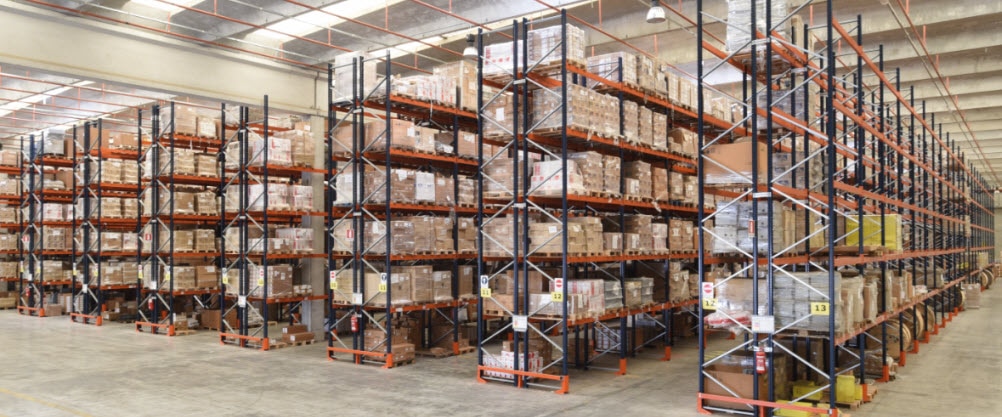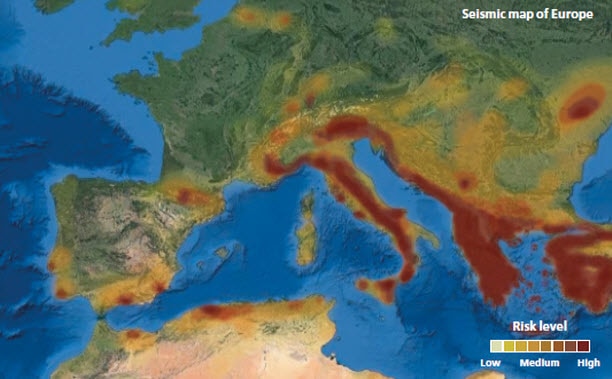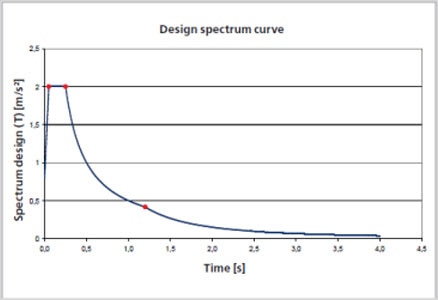The highest seismic hazard values and the likelihood of earthquakes occurring converge typically in regions close to the edges of Earth's tectonic plates. In Europe, the countries with the greatest seismic risk are Italy, Greece, Turkey, Cyprus and Iceland. At the same time, in each country, there are areas at higher risk than others. Prevention, as well as the compliance with European standards regarding the design and construction of storage systems, is fundamental for the earthquake-proofing of racks.

Unlike conventional civil engineering structures, racks are designed specifically to withstand heavy loads. The stability of the housed merchandise is guaranteed by the connections between the uprights and the beams, as well as by the latticework structure called the frame.
Rack components are made out of high-strength steel profiles that are between 1/16” and 1/8” thick. They are subject to general, local and also distortional buckling, especially in the uprights. Predicting the structural behavior of the racking is very complicated and, for that reason, its design requires tests to find out the mechanical characteristics of the components and their connections.
Earthquake-proof design of the racks
The design of the racks located in areas with a high seismic risk is much more complicated in relation to the racks located in other zones. The reason is that not only must they be able to withstand the dynamic forces (both horizontal and vertical) and the mechanisms of global or local collapse, but they also must avoid the collapse of pallets during an earthquake. 
Falling pallets can cause severe damage to property, people and the structure of the racks, not to mention the economic loss to the warehouse owner, which is higher than the cost of the racks and the reinforcement to withstand earthquakes.
In Europe, up to a few years ago, there was no official documentation on the seismic design of the racks and designers referred to the instructions provided by the Rack Manufacturers Institute (RMI).
This North American trade association brings together companies from the material handling industry. Among its best practices goals for the sector is information on how to account for seismic actions.
In addition to these instructions, the designers also based their work on the Eurocode 8 of the CEN (European Committee for Standardization), concerning the earthquake-proof design of structures (specifically for building).
However, the racks are particular steel structures whose behavior is a far cry from building structures. As a consequence, many of the structural configurations used in the racks were not fully covered under those standards.
To solve this problem, the European Racking Federation (ERF) –an association made up of Europe's largest manufacturers, including Mecalux– drafted the recommendations for the design of earthquake-proof racks that, in 2016, inspired the EN 16681 standard, approved by the European Commission.
This European-wide design standard allows the unification of the criteria that European manufacturers must meet when building their racks, which renders much safer structures. Obviously, American and Asian manufacturers must also design their products in accordance with that standard to access European markets.
Research programs
Research on the behavior of metal racks during earthquake tremors is very new. In fact, the very first studies were conducted in the United States after the quake in the town of Northbridge (Los Angeles), during the early morning of January 17, 1994.
Following the latest earthquakes in Europe –such as in Turkey in 1999 that had devastating consequences and a profound economic impact– and to compensate for the lack of studies on the dynamic behavior of metal racks during seismic tremors, the European Commission put three investigation programs into place:
- The Free Access to Large Scale Testing Facilities program, in 2002, in collaboration with the European Union and the Italian Ministry of Education.
- The Storage Racks in Seismic Areas (SEISRACKS) program, , through the Coal and Steel Research Fund, initiated in December of 2004 and completed in June of 2007. The primary objectives of this program were to discover rack behaviour and to design specific standards to withstand earthquakes.
In both programs, the behavior of the racking joints the racks comprise was evaluated. For this purpose, large-scale tests (by horizontal or vibratory table forces) were carried out to verify the interaction between pallets and racks, among other effects.
The vibrating table is capable of exerting vibrations on the tested elements to check the earthquake-proofing of structures, reproducing the same tremors that occur during an earthquake.
As a result of these studies and the knowledge gained during the investigations, an applicable code was formulated for palletized metal racks, FEM 10.2.08, issued in 2008.
- The Seismic Behavior of Steel Storage Pallet Racking Systems (SEISRACKS 2) program, in 2011. The purpose of this study was to identify the out-of-plane behavior of the beams, of the beam-upright connections and the entire structure.
The 2D racking calculations were done lengthwise (parallel to the aisles) and crosswise (perpendicular to the aisles). As a consequence, the beam only moves in the longitudinal direction.
Thanks to this program, it took into account the need to study the horizontal movements of the beam, when the unit load moves back and forth during an earthquake.
European regulations
In 2016, the EN 16681 standard was approved (Steel static storage systems. Adjustable pallet racking systems. Principles for seismic design), and whose final formulation was based on FEM 10.2.08, the comments received after its application, as well as on the results obtained from the research programs.
According to this standard, racks in earthquake-prone regions must be designed and constructed to meet the following requirements with an adequate degree of reliability:
1. Not to collapse
- The structure must be designed and constructed to withstand earthquakes without local or general collapse, maintaining its structural integrity and residual load capacity following a seismic event.
- Therefore, it must be verified that the structure meets the specified strength and ductility.
2. Limited damage
- A post-earthquake assessment of the level of damage in the structural elements is mandatory before reusing racks.
3. Movement of the unit loads
Seismic accelerations can cause the pallets to slip off beams when the static friction coefficient between the pallet and beam is exceeded. The consequences of these phenomena are:
- The reduction of the seismic action on the racks, due to the dissipation of energy and the limitation of the horizontal action that can be transferred from the pallet to the rack.
- The fall of the unit loads can cause either the local or global collapse of the racks, or injuries to people and damage to nearby equipment.

In addition, the EN 16681 states that the benchmark method of calculation is the modal spectral analysis, MRSA (Modal Response Spectrum Analysis).
The design of earthquake-proof structures requires, firstly, knowledge of the movements produced in the floor during an earthquake; said movement consists of displacements in any direction, combined with rotations of any axis.
In engineering, the seismic load is usually defined by an accelerogram. It is a time-acceleration graph of the terrain that represents the components of the acceleration in the horizontal and vertical directions produced by an earthquake in a given location.
Spectral modal analysis
MRSA is a study aimed at obtaining the set of horizontal actions that act on the racking levels, and that must be absorbed by frames, beams, braces, or their joints, among other components. It consists of estimating the response of the structure in the frequency domain rather than in the time domain. To do so, it is essential to know, on the one hand, the rigidity and natural behavior of the structure and, also, the design spectrum of each location.
The design spectrum is the representation of the terrain acceleration (accelerogram) in the frequency domain. The parameters will vary depending on the type of earthquake, the exact location of the installation with respect to the epicenter, as well as the composition of the terrain.
The spectrum represents the response of an idealized system to an acceleration in the frequency domain. Therefore, it permits knowledge of the structure’s reaction during an excitation frequency. For example, if a rack has a natural frequency (T1), forces for that frequency can be obtained via the spectrum.
When evaluating the rack's behavior, it is necessary to make a modal calculation (obtaining the natural modes of vibration and their frequencies) that includes:
- The behavior of the joints (rigidity).
- The mass of the product (loaded racks).
- The rack occupancy factor (how pallets are distributed, if there are empty levels, where the heaviest pallets are...).
- The reduction of system rigidity according to the load.
With all these data, the standard collects and normalizes how the majority of the most relevant and influential parameters (load type, degree of rack occupancy, type of unit load, among other factors) affect the racks. Furthermore, since it is a rack, other parameters that can modify the design spectrum must be considered, such as:
- The intensity of the earthquake.
- The number of levels.
- The total mass.
- The flexibility of the structure.
- The maximum horizontal force that can be transmitted between the load and the racks.
- The reduction of the seismic action based on vibratory table tests.
From this modal calculation, the individual seismic actions are found out for each direction. Hence, the effects in both directions are combined to obtain the design values of the seismic actions.
After achieving the design values of the seismic actions, combination rules must be applied. This application consists of combining the horizontal and vertical values related to the earthquake, as well as the weight of the racking and the unit loads.
Hereby the forces are obtained (the thrust the rack components must withstand) and it is verified that the racks will be able to withstand them. Subsequently, it is tested that the unit loads do not overturn or slide.
MRSA is the recommended method to calculate seismic actions, since the seismic spectra are easily generalized and normalized. The spectra represent the seismography of a given place, which avoids having to make multiple combinations from evolutionary calculations on various calculation accelerograms, which reduces calculation times and provides safe results. With lower intensity earthquakes, the LFMA (Lateral Force Method of Analysis) can be used, which consists of simulating the earthquake using a set of equivalent horizontal forces.
Mecalux takes on earthquakes
Mecalux has knowledge of and extensive experience in earthquake-prone regions. In that sense, its earthquake-proof facilities located in Turkey, Italy and Chile –the most earthquake-prone country in the world, due to its location on the Pacific's Belt of Fire– make for a natural laboratory for scientific research related to this phenomenon.
Within its engineering department, the company has a team specialized in designing racks capable of withstanding seismic actions. To this end, it uses the best quality materials, is at the forefront of the latest technological innovations and applies simulation based structural calculation programs.
The Mecalux methodology consists of generating a three-dimensional model of the structure using finite element programs. The data set inserted into it includes the type of materials, the dimensions of the profiles, the design spectrum, the characteristics of the unit loads, etc. Also, structural simulation is of vital importance to check the strength of the racks during earthquakes.
Mecalux is a leading international storage solutions manufacturer, known for its high quality and safety standards. Dedicated to developing earthquake-proof racks, it aims to ensure the integrity of structures, the stored products and, above all, the preservation of human life.
